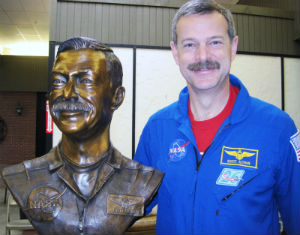Did you know? May 18th is National Museum Day.
- Details
 Did you know? May 18th is National Museum Day. Our State Museum is located in Springfield.
Did you know? May 18th is National Museum Day. Our State Museum is located in Springfield.
This Friday, several museums across the state are participating in National Museum Day by offering free admission and special event s. This is a great opportunity to explore the educational and cultural opportunities of our state.
To celebrate, we’ve highlighted our State museum, located in Springfield. It was founded in 1877 as a natural history museum, and was first housed in the State Capitol building.
Artist of the Month - Jesus Cruz
- Details
 Jesus Cruz is a barber and the owner of Cruz Cutz in Downtown Moline. He cuts a variety of intricate designs in his clients’ hair, including everything from a name to cartoon characters.
Jesus Cruz is a barber and the owner of Cruz Cutz in Downtown Moline. He cuts a variety of intricate designs in his clients’ hair, including everything from a name to cartoon characters.
How long have you been an artist or when did you start? Was there a single incident or moment when you realized this was your passion? If so, tell us about it.
I believe I’ve been an artist all my life. I was that kid in class that drew all over his notebooks and all his homework. I just really enjoyed being able to express myself in many ways. I always appreciated art, done with pencil, markers, spray paint and just art in general. Growing up, my dad got a few tattoos, and I remember thinking that was the coolest thing in the world. There used to be this magazine you could buy at the Mexican store called Low Rider, which had this section with a bunch of artists who draw using pencil. I would always go buy them and  be mesmerized by all the art in magazine. I would go home and try to mimic some of the pieces. That’s when I knew I had a passion for art.
be mesmerized by all the art in magazine. I would go home and try to mimic some of the pieces. That’s when I knew I had a passion for art.
Illinois has been factored into your work in the past. What does being able to live and work in Illinois mean to you?
Being able to work in Illinois and start up my business here is a great feeling. I have my family and friends here. I graduated in Moline, Illinois. So this is home to me. I’m very thankful to be able to work here.
What opportunities does Illinois present for local artists?
Illinois has a variety of local art fairs that artists can take advantage of and show off their work.
 What do you like about Illinois?
What do you like about Illinois?
I like that I’ve met people from all walks of life. It’s really inspired me and broadened my portfolio.
What is your favorite medium to work in?
My favorite medium right now I would have to say is hair. I own Cruz Cutz Barbershop here in Downtown Moline. So, cutting hair and doing hair designs is something I do every day. I’m able to express how I feel in these haircuts and have fun at the same time. I do anything from Super Mario, dog portraits, flowers, really anything in hair, and with hair growing back so fast, I always have a canvas.
What artist inspires you and why?
Artists all over the world inspire me, but I would have to say that tattoo artists are one of my biggest inspirations. I sometimes see people’s work and get inspired and transfer it into haircuts. It’s just a very cool form of art.
Where can people view or purchase your work?
My work can be found on Facebook and Instagram. I would say that my Instagram is my portfolio. It’s where most of my work goes. You can make appointments through Instagram or call the shop at (309)230-9399.
NASA inducted Pekin native Captain Scott Altman into the U.S. Astronaut's Hall of Fame
- Details
NASA inducted Pekin native Captain Scott Altman into the U.S. Astronaut’s Hall of Fame on April 21 with a ceremony at the Kennedy Space Center Visitor Complex. Altman is one of 98 other American astronauts to receive that honor, including Neil Armstrong, John Young and Gordon Fullerton.
inducted Pekin native Captain Scott Altman into the U.S. Astronaut’s Hall of Fame on April 21 with a ceremony at the Kennedy Space Center Visitor Complex. Altman is one of 98 other American astronauts to receive that honor, including Neil Armstrong, John Young and Gordon Fullerton.
Altman began his journey at Edison Junior High School in Pekin before continuing his education at the University of Illinois Champaign-Urbana. There he studied aeronautical and astronautical engineering before joining the Navy and rising to the rank of captain. He later earned a Master of Science degree in aeronautical engineering from the Naval Postgraduate School.
Two Illinois-based companies named among best for women of color
- Details
 Illinois-based insurance companies Allstate and State Farm are among 25 companies named this year as the organizations with the strongest representation of ethnic and racial diversity among women by Working Mother.
Illinois-based insurance companies Allstate and State Farm are among 25 companies named this year as the organizations with the strongest representation of ethnic and racial diversity among women by Working Mother.
For the first time this year, Working Mother also examined demographic categories by specific races and ethnicities and among people who identify as two or more races in order to pinpoint where companies have the most success and opportunities in hiring and promoting women from diverse backgrounds. Working Mother Media has conducted the survey since 2003.



